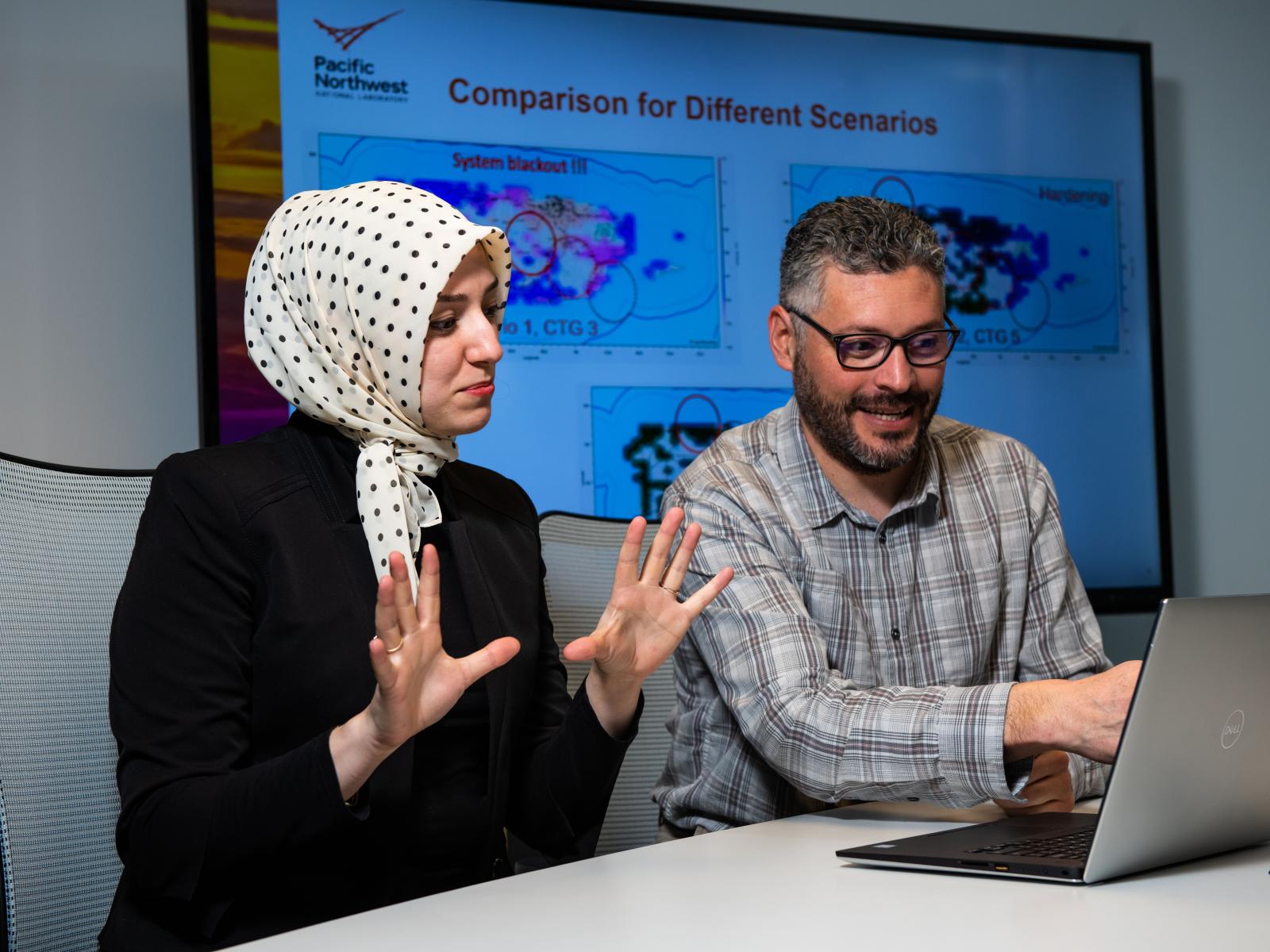Tri-Cities Researchers Work to Protect Electric Grid From Mother Nature’s Fury

Electrical engineers Sarah Davis and Marcelo Elizondo use the Dynamic Contingency Analysis Tool (DCAT), software developed by PNNL that analyzes extreme events, evaluates contingencies and provides grid operators with recommended corrective actions to avoid system failures.
(Photo by Andrea Starr | Pacific Northwest National Laboratory)
This year’s bout of winter storms and road closures may be behind us, but researchers at the Department of Energy’s Pacific Northwest National Laboratory work year-round to protect our energy infrastructure from freezing temperatures, wildfires and floods.
The widespread, long-lasting power outages in Texas in February were a sobering example of how weather can wreak havoc on our energy systems. The crisis was a perfect storm of unprecedented and ill-timed conditions. It illustrated how planning and operating the electricity grid is incredibly complex, with interdependencies among water utilities, electricity generation, natural gas supply, communication systems and more.
PNNL researchers are developing tools to anticipate and respond to events that could threaten grid reliability, whether natural or manmade. Other tools assist in balancing available resources and intermittent supply. And as co-leader of DOE’s Grid Modernization Laboratory Consortium, PNNL is one of 14 national labs teaming with more than 200 industry partners to better understand the interdependencies and operational constraints across the energy system during extreme conditions.
The tools being developed—many using artificial intelligence and machine learning techniques—focus on analyzing, modeling and simulating the interconnection of the electric grid, as well as other critical energy and information systems. Equipped with this kind of situational awareness, operators can better predict, plan for and respond to hazards.
One PNNL-developed software tool, the Dynamic Contingency Analysis Tool, or DCAT, simulates cascading failures in which generators, transmission lines and end users become disconnected in a series of events that ultimately could spiral into a wide-area blackout. DCAT performs contingency analyses, or a series of “what-if” questions, evaluating system response to various scenarios. The award-winning software integrates models for protecting against these failures, rapidly generating recommendations for automatic or manual corrective actions.
Extreme weather events are occurring more frequently due to climate change and can cause serious physical damage to critical infrastructure. PNNL experts in modeling and remote sensing are helping here, too. Another award-winning technology, PNNL’s Rapid Analytics for Disaster Response software suite, analyzes aerial and satellite imagery to provide detailed damage assessments in the wake of an extreme event.

Known as RADR, the software is eight times faster than traditional methods and can produce results in cloudy, smoky or nighttime conditions, providing vital information to utilities and emergency responders in the field.
Where RADR helps assess damage after it has happened, PNNL’s Rapid Infrastructure Flood Tool helps predict where flooding might occur, allowing planners to better prepare and respond. Last year, for example, researchers provided flood simulations twice daily as hurricanes Marco, Laura, Sally and Tropical Storm Cristobal began brewing.
Their data, based on rainfall forecasts as the storms moved along the coast, improved projections of potential impacts. Following the hurricanes, they compared before and after images to detect damage and support recovery operations, including restoring power and identifying necessary system repairs.

On the planning front, PNNL provides the U.S. Nuclear Regulatory Commission with an alternative to conventional flood hazard assessments for nuclear power plants that currently plan for worst-case scenarios. Given the limited data available, uncertainties arise when trying to define events with a near-zero chance of occurring. Instead, PNNL researchers conduct probabilistic analyses that examine the likelihood of a flood of a certain magnitude occurring at a specific location.
The researchers’ models and simulations help address uncertainties and enable a more consistent, transparent and realistic understanding of risk. This kind of risk analysis could inform supplemental safety measures to protect the public and the environment. They also could aid in the design of more resilient critical infrastructure, including future nuclear power plants.
Mother Nature will undoubtedly unleash her fury from time to time, but you can count on PNNL researchers to develop and deliver technologies that will keep the lights on and the energy system humming.
Steven Ashby, director of Pacific Northwest National Laboratory, writes this column monthly. To read previous Director's Columns, visit pnnl.gov/news and filter by Director's Columns in our Latest Stories.
Published: March 22, 2021